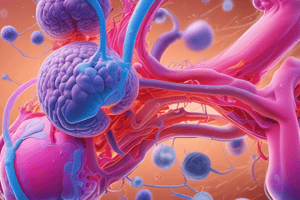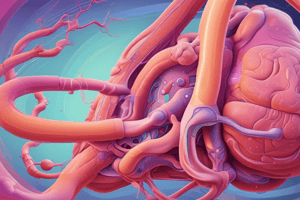Podcast
Questions and Answers
Which of the following substances are excluded from moving through the glomerular filtration barrier?
Which of the following substances are excluded from moving through the glomerular filtration barrier?
- Low-molecular-weight organic solutes
- Inorganic ions
- Plasma proteins (correct)
- Water
The glomerular filtration rate (GFR) in a normal young adult male is approximately 180 L/day.
The glomerular filtration rate (GFR) in a normal young adult male is approximately 180 L/day.
True (A)
What is the primary site of glomerular filtration?
What is the primary site of glomerular filtration?
Bowman's capsule
The equation to express urinary excretion rate is: Urinary excretion rate = Filtration rate - _____ + Secretion rate.
The equation to express urinary excretion rate is: Urinary excretion rate = Filtration rate - _____ + Secretion rate.
Match the renal processes with their definitions:
Match the renal processes with their definitions:
How many times is the total plasma volume filtered by the kidneys in a day?
How many times is the total plasma volume filtered by the kidneys in a day?
All substances that are freely filtered by the glomerular capillaries are also completely reabsorbed.
All substances that are freely filtered by the glomerular capillaries are also completely reabsorbed.
What happens to the composition of glomerular filtrate as it passes through the renal tubules?
What happens to the composition of glomerular filtrate as it passes through the renal tubules?
What happens to substances that are freely filtered and totally reabsorbed from the tubules?
What happens to substances that are freely filtered and totally reabsorbed from the tubules?
The total area of glomerular capillary endothelium across which filtration occurs is approximately 0.8 m².
The total area of glomerular capillary endothelium across which filtration occurs is approximately 0.8 m².
What condition occurs when proteins, like albumin, are filtered into the urine due to a loss of negative charge on the basement membrane?
What condition occurs when proteins, like albumin, are filtered into the urine due to a loss of negative charge on the basement membrane?
The glomerular capillary membrane consists of three major layers: endothelial cells, the basement membrane, and ______.
The glomerular capillary membrane consists of three major layers: endothelial cells, the basement membrane, and ______.
Match the following substances with their excretion rates:
Match the following substances with their excretion rates:
Which statement correctly describes the role of mesangial cells in the glomerulus?
Which statement correctly describes the role of mesangial cells in the glomerulus?
Podocytes do not have a significant negative charge.
Podocytes do not have a significant negative charge.
The thickness of the basement membrane in the glomerular capillary membrane is about ______.
The thickness of the basement membrane in the glomerular capillary membrane is about ______.
What is the maximum diameter of neutral substances that can freely pass through the glomerular membrane?
What is the maximum diameter of neutral substances that can freely pass through the glomerular membrane?
Most plasma proteins are effectively filtered through the glomerular membrane.
Most plasma proteins are effectively filtered through the glomerular membrane.
What is the typical filtration fraction (FF) in the kidneys?
What is the typical filtration fraction (FF) in the kidneys?
The net filtration pressure is the algebraic sum of the four ______ pressures.
The net filtration pressure is the algebraic sum of the four ______ pressures.
Match the following pressures to their respective roles in filtration:
Match the following pressures to their respective roles in filtration:
Which statement about the electrical charge of the glomerular membrane components is correct?
Which statement about the electrical charge of the glomerular membrane components is correct?
The Glomerular filtration rate (GFR) can be calculated using the formula GFR = Kf x net filtration pressure.
The Glomerular filtration rate (GFR) can be calculated using the formula GFR = Kf x net filtration pressure.
What is the equation used to determine the net filtration pressure in the glomerulus?
What is the equation used to determine the net filtration pressure in the glomerulus?
What is the normal glomerular filtration rate (GFR)?
What is the normal glomerular filtration rate (GFR)?
Increased Bowman's capsule hydrostatic pressure leads to an increase in GFR.
Increased Bowman's capsule hydrostatic pressure leads to an increase in GFR.
What does Kf represent in the context of glomerular filtration?
What does Kf represent in the context of glomerular filtration?
The normal Kf is calculated to be about _____ ml/min/mm Hg of filtration pressure for both kidneys.
The normal Kf is calculated to be about _____ ml/min/mm Hg of filtration pressure for both kidneys.
Match the factors with their effects on GFR:
Match the factors with their effects on GFR:
Which factor does NOT contribute to a decrease in GFR?
Which factor does NOT contribute to a decrease in GFR?
The Kf of renal capillary glomeruli is significantly lower than that of most other capillary systems in the body.
The Kf of renal capillary glomeruli is significantly lower than that of most other capillary systems in the body.
What are two factors that can lead to an increase in GFR?
What are two factors that can lead to an increase in GFR?
What is the primary effect of angiotensin II on renal arterioles?
What is the primary effect of angiotensin II on renal arterioles?
Prostaglandins act as vasodilators in the kidneys, countering the effects of the sympathetic nervous system and angiotensin II.
Prostaglandins act as vasodilators in the kidneys, countering the effects of the sympathetic nervous system and angiotensin II.
What is the role of dopamine at low levels in the treatment of hemorrhage?
What is the role of dopamine at low levels in the treatment of hemorrhage?
The _____ is the most potent vasoconstrictor that is produced by endothelial cells.
The _____ is the most potent vasoconstrictor that is produced by endothelial cells.
Match the substance with its effect on renal arterioles:
Match the substance with its effect on renal arterioles:
How do NSAIDs affect renal function?
How do NSAIDs affect renal function?
Nitric oxide is released by endothelial cells in response to increased shear stress or pressure and is a potent vasoconstrictor.
Nitric oxide is released by endothelial cells in response to increased shear stress or pressure and is a potent vasoconstrictor.
What happens when renin-angiotensin system is activated during hemorrhage?
What happens when renin-angiotensin system is activated during hemorrhage?
Flashcards
Glomerular filtration
Glomerular filtration
The movement of fluid from glomerular capillaries into Bowman's capsule.
Filtrate composition
Filtrate composition
Filtrate contains most inorganic ions and low-molecular-weight organic solutes.
Glomerular Filtration Rate (GFR)
Glomerular Filtration Rate (GFR)
Volume of filtrate formed per unit time; crucial for kidney function.
Normal adult GFR
Normal adult GFR
Signup and view all the flashcards
Urine formation steps
Urine formation steps
Signup and view all the flashcards
Excretion rate vs Filtration rate
Excretion rate vs Filtration rate
Signup and view all the flashcards
Freely filtered substances
Freely filtered substances
Signup and view all the flashcards
Partially reabsorbed substances
Partially reabsorbed substances
Signup and view all the flashcards
Totally reabsorbed substances
Totally reabsorbed substances
Signup and view all the flashcards
Substances filtered, secreted
Substances filtered, secreted
Signup and view all the flashcards
Glomerular capillary membrane layers
Glomerular capillary membrane layers
Signup and view all the flashcards
Endothelial cells (glomerulus)
Endothelial cells (glomerulus)
Signup and view all the flashcards
Basement membrane (glomerulus)
Basement membrane (glomerulus)
Signup and view all the flashcards
Epithelial cells (glomerulus)
Epithelial cells (glomerulus)
Signup and view all the flashcards
Mesangial Cells
Mesangial Cells
Signup and view all the flashcards
Filtration Molecular Size
Filtration Molecular Size
Signup and view all the flashcards
Filtration Electrical Charge
Filtration Electrical Charge
Signup and view all the flashcards
Filtration Fraction
Filtration Fraction
Signup and view all the flashcards
Starling Forces
Starling Forces
Signup and view all the flashcards
Glomerular Hydrostatic Pressure (PG)
Glomerular Hydrostatic Pressure (PG)
Signup and view all the flashcards
Bowman's Capsule Hydrostatic Pressure (PB)
Bowman's Capsule Hydrostatic Pressure (PB)
Signup and view all the flashcards
Study Notes
Glomerular Filtration
- The bulk flow of fluid from the glomerular capillaries into Bowman's capsule
- The filtrate contains most inorganic ions and low-molecular-weight organic solutes
- The glomerular filtration rate (GFR) is the volume of filtrate formed per unit time
- In a normal young adult male, the GFR is an incredible 180 L/day (125 mL/min)
- Urine formation results from glomerular filtration, tubular reabsorption, and tubular secretion
- Urinary excretion rate = Filtration rate - Reabsorption rate + Secretion rate
Renal Handling of Substances
- Some substances are freely filtered, but neither reabsorbed nor secreted, therefore excretion rate = filtration rate
- Some substances are freely filtered, but partly reabsorbed, therefore urinary excretion rate is less than filtration rate
- Some substances are freely filtered and totally reabsorbed, resulting in a zero urinary excretion rate
- Some substances are freely filtered and not reabsorbed, but are secreted, therefore excretion rate = filtration rate + tubular secretion rate
Structure of Glomerular Capillary Membrane
- The glomerular capillary membrane has three major layers:
- Endothelial cells: Perforated by large fenestrae ("windows") and rich in fixed negative charges
- Basement membrane: About 50nm thick, contains glycoproteins and proteoglycans, and has a net negative charge.
- In minimal change nephropathy, the negative charges are lost leading to proteinuria or albuminuria
- Epithelial cells: Contain podocytes with pedicels which interdigitate forming slits through which the filtrate enters Bowman's space. Podocyte membranes also have a high density of negative charge
- The glomerulus also contains mesangial cells, which act as phagocytes and can contract
Factors Affecting Filtration
- The glomerular capillary membrane is thicker than most other capillaries, but more porous
- Filtration rate of any substance depends on:
- Molecular size: Freely passes neutral substances up to 4nm, but almost completely excludes those greater than 8nm
- Electrical charge: Negatively charged molecules are impeded by electrostatic repulsion; positively charged molecules are favored
- Filtration fraction (FF): The fraction of the renal plasma flow that is filtered, averaging about 0.2
Determinants of GFR
- The pressures driving fluid movement across the glomerular capillary wall are the Starling forces:
- Glomerular hydrostatic pressure (PG): Pressure within the glomerular capillary
- Bowman's capsule hydrostatic pressure (PB): Pressure within Bowman's capsule
- Glomerular capillary colloid osmotic pressure (πG): Pressure due to proteins in the glomerular capillary
- Bowman's capsule colloid osmotic pressure (πB): Pressure due to proteins in Bowman's space
- GFR = Kf x net ultrafiltration pressure
- Net filtration pressure = Forces Favoring Filtration - Forces Opposing Filtration
- Forces Favoring Filtration: PG (60 mmHg) and πB (0 mmHg)
- Forces Opposing Filtration: PB (18 mmHg) and πG (32 mmHg)
- Net filtration pressure = [(60 + 0) - (18 + 32)] = 10 mmHg
Filtration Coefficient (Kf)
- Kf is the water permeability of the glomerular capillary wall
- Kf is calculated from GFR and net filtration pressure
- Normal Kf is about 12.5 ml/min/mm Hg
- Kf of renal capillary glomeruli is 400 times higher than other capillary systems
Factors Decreasing GFR
- Decreased Kf
- Uncontrolled hypertension
- Diabetes mellitus (thickening of glomerular basement membrane)
- Increased Bowman's capsule hydrostatic pressure
- Obstruction of urine flow (e.g., ureteral stone)
- Increased glomerular capillary colloid osmotic pressure
- Constriction of the afferent arteriole
Factors Increasing GFR
- Increased glomerular capillary hydrostatic pressure
- Increased arterial pressure
- Increased efferent arteriolar resistance
- Increased sympathetic nerve activity
- Vasoconstriction of afferent and efferent arterioles
- Reduced renal blood flow
- Prostaglandins (e.g., PGE2, PGI2)
- Vasodilation of afferent and efferent arterioles
- Dopamine (low doses)
- Vasodilation of cerebral, cardiac, splanchnic and renal arterioles
- Nitric oxide (NO)
- Vasodilation of afferent and efferent arterioles
- Released by endothelial cells in response to increased shear stress or pressure
- Endothelin
- Potent vasoconstrictor of endothelial origin
- Implicated in the nephrotoxicity of some drugs (e.g., cyclosporine)
Studying That Suits You
Use AI to generate personalized quizzes and flashcards to suit your learning preferences.




